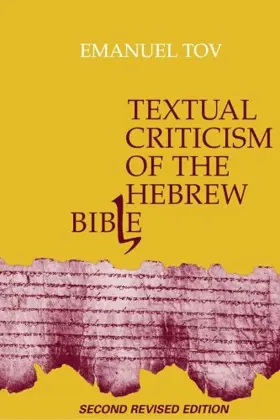

Textual Criticism of the Hebrew Bible
Pages
500
Publisher
Augsburg Fortress Press
Published
7/1/2001
ISBN-13
9780800634292
An accessible approach to critical evaluation of the Old Testament, this book includes a detailed discussion of the transmittal of the Bible during the period of the Second Temple as well as extensive information on textual and literary criticism, including the relevance of the historical context.
Reviews
The best introduction to the subject. The best introduction to the subject.
[Full Review]
If one were asked to make a list of books that would be most useful in the library of someone serious about biblical studies, Tov�s book would surely be near the top of the list. This is the second revised edition of a work first published in 1992. The sheer volume of reliable information, presented in a clear and readable manner, along with intelligent methodological discussions, have already made this work a classic. The scope of Tov�s w ork makes it impossible to give a brief description of its contents. After an extensive introduction (ch. 1), chapter 2 gives a detailed introduction to �Textual Witnesses of the Bible.� Pages 22�79 alone deal with all aspects of the Masoretic text (MT), ranging from its ancestry in the Qumran proto-MT to details of the Masorah such as the puncta extraordinaria (extraordinary points [fifteen cases of dotted letters]). Tov then provides extensive introductions to the Samaritan Pentateuch (and the Qumran pre-Samaritan texts), the Qumran biblical texts, and the various translations, especially the Septuagint (LXX). On the way, smaller and more indirect witnesses, such as the silver amulets containing the priestly blessing from Ketef Hinnom, are not neglected.
[Full Review]
Minneapolis: Fortress Press, 2001. Pp. xl + 456, Cloth, $50.00, ISBN 0800634292. Edition: Second Revised A. H. Konkel Providence Theological Seminary Otterburne, MB R0A 1G0 The title of this book is a good description of its purpose, but it does not indicate the wealth of information included, all of which must be understood and evaluated in order to accomplish the task stated. Textual criticism deals with the origin and nature of all forms of a text, and an analysis of the relationships between them. Textual criticism only deals with data deriving from textual transmission. This would exclude data of textual witnesses created at an earlier stage during the literary growth of Biblical books. In the case of the Hebrew Scriptures this task is complicated by two factors: more than one edition of a composition is included in the textual witnesses, and much of the textual evidence is known only in translations. There have been relatively few attempts to reconstruct the original text of a Biblical book (pp. 289, 372). The Hebrew Vorlage of the ancient translations cannot be reconstructed satisfactorily, and it is often impossible to make a decision with regard to the originality of readings. The Editor-in-Chief of the Dead Sea Scrolls is arguably one of the most qualified individuals to elucidate textual criticism of the Hebrew Bible. The Biblical manuscripts of the Scrolls increased the amount of textual data by approximately 220 manuscripts, providing textual evidence that goes back into the third century B.C.E. The witness of the Scrolls has transformed theories of composition and transmission, it has both clarified and complicated an understanding of the history of the text. It is now ten years since the first English edition of this work. A decade of continuing research has provided new publications of Biblical texts, and has led to some revision and clarification of the task of textual criticism. Recent bibliography has been incorporated in the new edition; the bibliographical abbreviations (pp. xxix-xxxiv) and the indexes of ancient sources and authors (pp. 411-442) have been modified accordingly.
[Full Review]

